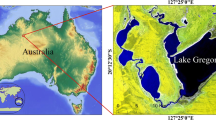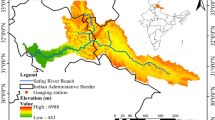Abstract
The vegetation of a river basin is affected by various climate factors, such as precipitation and land surface temperature (LST). This study explores the best machine learning model for the prediction of normalized difference vegetation index (NDVI) with LST and precipitation as input parameters. The study also determines the correlation between NDVI, LST, and precipitation of the Mahanadi basin from 2003 to 2021. Monthly precipitation data was extracted from the Center for Hydrometeorology and Remote Sensing (CHRS) portal. The Moderate Resolution Imaging Spectroradiometer (MODIS) products were used to derive the LST and NDVI using Google Earth Engine (GEE). Four different machine learning models were used to predict the NDVI of the Mahanadi basin: linear regression (LR), random forest (RF), support vector regression (SVR), and k-nearest neighbors (KNN). The coefficient of determination (R2), root mean square error (RMSE), mean square error (MSE), mean absolute error (MAE), and explained variance score (EVS) were calculated to evaluate the performance of the models. The results show that the RF model has the highest R2 value in both the training and testing sets among these models, indicating that it is the most optimal among these models for predicting NDVI. The SVR model has the lowest RMSE value in the training set, but the KNN model has the lowest RMSE value in the testing set. The results also show that there is a positive correlation between precipitation and NDVI, a negative correlation between precipitation and LST, and between NDVI and LST. This study provides insights into the relationship between NDVI, LST, and precipitation, and the best machine-learning model for predicting NDVI. The findings of this study can be used to improve the management of river basins and to predict the effects of climate change on vegetation.








Similar content being viewed by others
Data availability
The data regarding precipitation for the study area were acquired from the portal of the Center for Hydrometeorology and Remote Sensing portal (https://chrs.web.uci.edu/). NDVI and LST data for the study area were obtained from the USGS website (https://lpdaac.usgs.gov/products/mod13a1v006/) (https://lpdaac.usgs.gov/products/mod11a2v006/).
References
Abbas, A., He, Q., **, L., Li, J., Salam, A., Lu, B., & Yasheng, Y. (2021). Spatio-temporal changes of land surface temperature and the influencing factors in the Tarim basin, northwest China. Remote Sensing, 13(19), 1–20. https://doi.org/10.3390/rs13193792
Abera, T. A., Heiskanen, J., Pellikka, P., & Maeda, E. E. (2018). Rainfall–vegetation interaction regulates temperature anomalies during extreme dry events in the Horn of Africa. Global and Planetary Change, 167, 35–45. https://doi.org/10.1016/j.gloplacha.2018.05.002
Ahmad, R., Yang, B., Ettlin, G., Berger, A., & Rodríguez-Bocca, P. (2023). A machine-learning based ConvLSTM architecture for NDVI forecasting. International Transactions in Operational Research, 30(4), 2025–2048. https://doi.org/10.1111/itor.12887
Chang, C. T., Lin, T. C., Wang, S. F., & Vadeboncoeur, M. A. (2011). Assessing growing season beginning and end dates and their relation to climate in Taiwan using satellite data. International Journal of Remote Sensing, 32(18), 5035–5058. https://doi.org/10.1080/01431161.2010.494635
Deng, Y., Wang, S., Bai, X., Tian, Y., Wu, L., **ao, J., Chen, F., & Qian, Q. (2018). Relationship among land surface temperature and LUCC, NDVI in typical karst area. Scientific Reports, 8(1), 1–12. https://doi.org/10.1038/s41598-017-19088-x
Ding, M., Zhang, Y., Liu, L., Zhang, W., Wang, Z., & Bai, W. (2007). The relationship between NDVI and precipitation on the Tibetan Plateau. Journal of Geographical Sciences, 17(3), 259–268. https://doi.org/10.1007/s11442-007-0259-7
Gao, J., Jiao, K., & Wu, S. (2019). Investigating the spatially heterogeneous relationships between climate factors and NDVI in China during 1982 to 2013. Journal of Geographical Sciences, 29(10), 1597–1609. https://doi.org/10.1007/s11442-019-1682-2
Gao, P., Du, W., Lei, Q., Li, J., Zhang, S., & Li, N. (2023). NDVI forecasting model based on the combination of time series decomposition and CNN–LSTM. Water Resources Management, 0123456789. https://doi.org/10.1007/s11269-022-03419-3
Garai, S., Khatun, M., Singh, R., Sharma, J., Pradhan, M., Ranjan, A., Rahaman, S. M., Khan, M. L., & Tiwari, S. (2022). Assessing correlation between Rainfall, normalized difference Vegetation Index (NDVI) and land surface temperature (LST) in Eastern India. Safety in Extreme Environments, 4(2), 119–127. https://doi.org/10.1007/s42797-022-00056-2
Ghebrezgabher, M. G., Yang, T., Yang, X., & Eyassu Sereke, T. (2020). Assessment of NDVI variations in responses to climate change in the Horn of Africa. Egyptian Journal of Remote Sensing and Space Science, 23(3), 249–261. https://doi.org/10.1016/j.ejrs.2020.08.003
Gogtay, N. J., & Thatte, U. M. (2017). Principles of correlation analysis. Journal of Association of Physicians of India, 65, 78–81.
Guha, S., & Govil, H. (2020). Land surface temperature and normalized difference vegetation index relationship: A seasonal study on a tropical city. SN Applied Sciences, 2(10), 1–14. https://doi.org/10.1007/s42452-020-03458-8
India-WRIS. (2014). India Water Resources Information System. Available at: https://indiawris.gov.in/wris/#/Basin. Accessed Oct 2023
Jose, D. M., Vincent, A. M., & Dwarakish, G. S. (2022). Improving multiple model ensemble predictions of daily precipitation and temperature through machine learning techniques. Scientific Reports, 12(1), 1–25. https://doi.org/10.1038/s41598-022-08786-w
Kileshye Onema, J. M., & Taigbenu, A. (2009). NDVI-rainfall relationship in the Semliki watershed of the equatorial Nile. Physics and Chemistry of the Earth, 34(13–16), 711–721. https://doi.org/10.1016/j.pce.2009.06.004
Kumar, M., Elbeltagi, A., Pande, C. B., Ahmed, A. N., Chow, M. F., Pham, Q. B., Kumari, A., & Kumar, D. (2022). Applications of data-driven models for daily discharge estimation based on different input combinations. Water Resources Management, 36(7), 2201–2221. https://doi.org/10.1007/s11269-022-03136-x
Kumar, M., Kumar, P., Kumar, A., Elbeltagi, A., & Kuriqi, A. (2022). Modeling stage–discharge–sediment using support vector machine and artificial neural network coupled with wavelet transform. Applied Water Science, 12(5), 1–21. https://doi.org/10.1007/s13201-022-01621-7
Kundu, A., Denis, D. M., Patel, N. R., & Dutta, D. (2018). A Geo-spatial study for analysing temporal responses of NDVI to rainfall. Singapore Journal of Tropical Geography, 39(1), 107–116. https://doi.org/10.1111/sjtg.12217
Li, X., Yuan, W., & Dong, W. (2021). A machine learning method for predicting vegetation indices in China. Remote Sensing, 13(6). https://doi.org/10.3390/rs13061147
LP DAAC - MOD11A2. (n.d.). USGS Earth Engine Data Catalog. Available at: https://lpdaac.usgs.gov/products/mod11a2v006/
LP DAAC - MOD13A1. (n.d.). USGS Earth Engine Data Catalog. Available at: https://lpdaac.usgs.gov/products/mod13a1v006/
Ma, Y., Zuo, L., Gao, J., Liu, Q., & Liu, L. (2021). Comparing four types methods for karst NDVI prediction based on machine learning. Atmosphere, 12(10). https://doi.org/10.3390/atmos12101341
Mahmoodzadeh, A., Mohammadi, M., Ali, H. F. H., Abdulhamid, S. N., Ibrahim, H. H., & Noori, K. M. G. (2021). Dynamic prediction models of rock quality designation in tunneling projects. Transportation Geotechnics, 27, 100497. https://doi.org/10.1016/j.trgeo.2020.100497
Mallick, J., Almesfer, M. K., Singh, V. P., Falqi, I. I., Singh, C. K., Alsubih, M., & Kahla, N. B. (2021). Evaluating the NDVI–rainfall relationship in Bisha watershed, Saudi Arabia using non-stationary modeling technique. Atmosphere, 12(5). https://doi.org/10.3390/atmos12050593
Martínez, F., Frías, M. P., Pérez, M. D., & Rivera, A. J. (2019). A methodology for applying k-nearest neighbor to time series forecasting. Artificial Intelligence Review, 52(3), 2019–2037. https://doi.org/10.1007/s10462-017-9593-z
Naga Rajesh, A., Abinaya, S., Purna Durga, G., & Lakshmi Kumar, T. V. (2023). Long-term relationships of MODIS NDVI with rainfall, land surface temperature, surface soil moisture and groundwater storage over monsoon core region of India. Arid Land Research and Management, 37(1), 51–70. https://doi.org/10.1080/15324982.2022.2106323
Raje, D., & Mujumdar, P. P. (2009). A conditional random field-based downscaling method for assessment of climate change impact on multisite daily precipitation in the Mahanadi basin. Water Resources Research, 45(10), 1–20. https://doi.org/10.1029/2008WR007487
Ramachandra, T. V., Kumar, U., & Dasgupta, A. (2016). Analysis of land surface temperature and rainfall with landscape dynamics in Western Ghats, India. Journal of the Indian Institute of Science, 22933099(D) https://www.researchgate.net/profile/Sahyadri_Environmental_Information_System/publication/318786685_Analysis_of_Land_Surface_Temperature_and_Rainfall_with_Landscape_Dynamics_in_Western_Ghats_India/links/597ec28aa6fdcc1a9accb94e/Analysis-of-Land-Surface-T
Shen, M., Sun, H., & Lu, Y. (2017). Household electricity consumption prediction under multiple behavioural intervention strategies using support vector regression. Energy Procedia, 142, 2734–2739. https://doi.org/10.1016/j.egypro.2017.12.218
Stas, M., Van Orshoven, J., Dong, Q., Heremans, S., & Zhang, B. (2016). A comparison of machine learning algorithms for regional wheat yield prediction using NDVI time series of SPOT-VGT. 2016 5th International Conference on Agro-Geoinformatics, Agro-Geoinformatics 2016, 1–5. https://doi.org/10.1109/Agro-Geoinformatics.2016.7577625
Suharyanto, A., Maulana, A., Suprayogo, D., Devia, Y. P., & Kurniawan, S. (2023). Land surface temperature changes caused by land cover/land use properties and their impact on rainfall characteristics. Global Journal of Environmental Science and Management, 9(3), 353–372. https://doi.org/10.22035/gjesm.2023.03.01
Tamiminia, H., Salehi, B., Mahdianpari, M., Quackenbush, L., Adeli, S., & Brisco, B. (2020). Google Earth Engine for geo-big data applications: A meta-analysis and systematic review. ISPRS Journal of Photogrammetry and Remote Sensing, 164, 152–170. https://doi.org/10.1016/j.isprsjprs.2020.04.001
Teferi, E., Uhlenbrook, S., Bewket, W., Wenninger, J., & Simane, B. (2010). The use of remote sensing to quantify wetland loss in the Choke Mountain range, Upper Blue Nile basin, Ethiopia. Hydrology and Earth System Sciences, 14(12), 2415–2428. https://doi.org/10.5194/hess-14-2415-2010
Uyanık, G. K., & Güler, N. (2013). A study on multiple linear regression analysis. Procedia - Social and Behavioral Sciences, 106, 234–240. https://doi.org/10.1016/j.sbspro.2013.12.027
Wang, J., Rich, P. M., & Price, K. P. (2003). Temporal responses of NDVI to precipitation and temperature in the central Great Plains, USA. International Journal of Remote Sensing, 24(11), 2345–2364. https://doi.org/10.1080/01431160210154812
Yang, L., Shen, F., Zhang, L., Cai, Y., Yi, F., & Zhou, C. (2021). Quantifying influences of natural and anthropogenic factors on vegetation changes using structural equation modeling: A case study in Jiangsu Province, China. Journal of Cleaner Production, 280, 124330. https://doi.org/10.1016/j.jclepro.2020.124330
Zarei, A., Asadi, E., Ebrahimi, A., Jafari, M., Malekian, A., Mohammadi Nasrabadi, H., Chemura, A., & Maskell, G. (2020). Prediction of future grassland vegetation cover fluctuation under climate change scenarios. Ecological Indicators, 119, 106858. https://doi.org/10.1016/j.ecolind.2020.106858
Zhou, Z., Ding, Y., Shi, H., Cai, H., Fu, Q., Liu, S., & Li, T. (2020). Analysis and prediction of vegetation dynamic changes in China: Past, present and future. Ecological Indicators, 117, 106642. https://doi.org/10.1016/j.ecolind.2020.106642
Zou, F., Li, H., & Hu, Q. (2020). Responses of vegetation greening and land surface temperature variations to global warming on the Qinghai-Tibetan Plateau, 2001–2016. Ecological Indicators, 119, 106867. https://doi.org/10.1016/j.ecolind.2020.106867
Acknowledgements
The authors extend their sincere gratitude to the editor and anonymous reviewers for their invaluable insights and dedicated efforts in enhancing the quality of our manuscript. Their thoughtful comments and constructive feedback have greatly contributed to its improvement.
Author information
Authors and Affiliations
Contributions
GT conceived the idea, conducted background research, and provided research supervision. DKR contributed to data collection, workflow development, assessment, and led the writing process of the manuscript, with both authors contributing to its composition.
Corresponding author
Ethics declarations
Ethics approval
This article does not involve studies with human participants or animals conducted by any of the authors. No ethics approval was required.
Consent to participate
All contributors to the design of this manuscript have willingly provided their consent for its submission.
Consent for publication
All authors have given their consent to publish this manuscript
Competing interests
The authors declare no competing interests.
Additional information
Publisher’s note
Springer Nature remains neutral with regard to jurisdictional claims in published maps and institutional affiliations.
Rights and permissions
Springer Nature or its licensor (e.g. a society or other partner) holds exclusive rights to this article under a publishing agreement with the author(s) or other rightsholder(s); author self-archiving of the accepted manuscript version of this article is solely governed by the terms of such publishing agreement and applicable law.
About this article
Cite this article
Raj, D.K., Gopikrishnan, T. Machine learning models for predicting vegetation conditions in Mahanadi River basin. Environ Monit Assess 195, 1401 (2023). https://doi.org/10.1007/s10661-023-12006-x
Received:
Accepted:
Published:
DOI: https://doi.org/10.1007/s10661-023-12006-x




